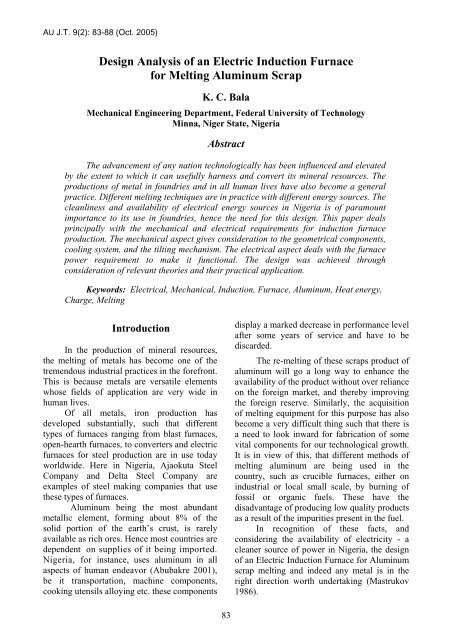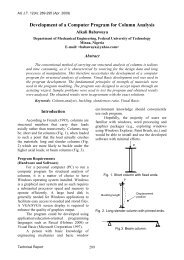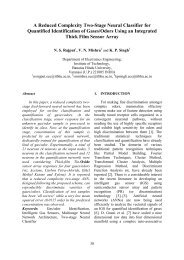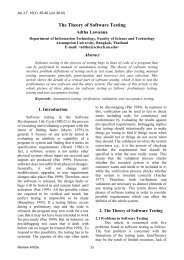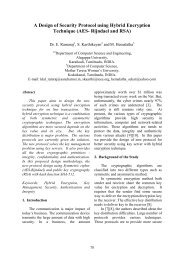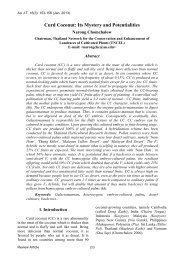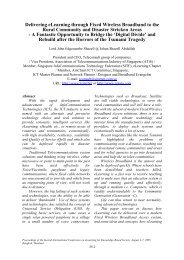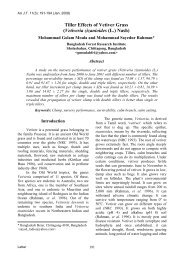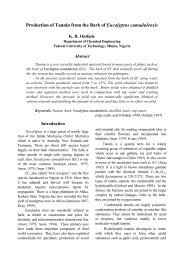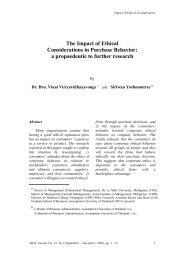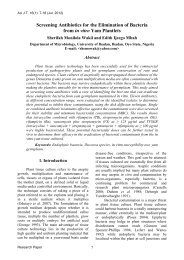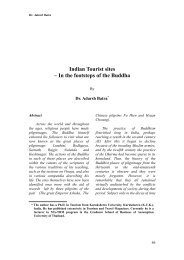Design Analysis of an Electric Induction Furnace for ... - AU Journal
Design Analysis of an Electric Induction Furnace for ... - AU Journal
Design Analysis of an Electric Induction Furnace for ... - AU Journal
Create successful ePaper yourself
Turn your PDF publications into a flip-book with our unique Google optimized e-Paper software.
<strong>AU</strong> J.T. 9(2): 83-88 (Oct. 2005)<br />
<strong>Design</strong> <strong>Analysis</strong> <strong>of</strong> <strong>an</strong> <strong>Electric</strong> <strong>Induction</strong> <strong>Furnace</strong><br />
<strong>for</strong> Melting Aluminum Scrap<br />
K. C. Bala<br />
Mech<strong>an</strong>ical Engineering Department, Federal University <strong>of</strong> Technology<br />
Minna, Niger State, Nigeria<br />
Abstract<br />
The adv<strong>an</strong>cement <strong>of</strong> <strong>an</strong>y nation technologically has been influenced <strong>an</strong>d elevated<br />
by the extent to which it c<strong>an</strong> usefully harness <strong>an</strong>d convert its mineral resources. The<br />
productions <strong>of</strong> metal in foundries <strong>an</strong>d in all hum<strong>an</strong> lives have also become a general<br />
practice. Different melting techniques are in practice with different energy sources. The<br />
cle<strong>an</strong>liness <strong>an</strong>d availability <strong>of</strong> electrical energy sources in Nigeria is <strong>of</strong> paramount<br />
import<strong>an</strong>ce to its use in foundries, hence the need <strong>for</strong> this design. This paper deals<br />
principally with the mech<strong>an</strong>ical <strong>an</strong>d electrical requirements <strong>for</strong> induction furnace<br />
production. The mech<strong>an</strong>ical aspect gives consideration to the geometrical components,<br />
cooling system, <strong>an</strong>d the tilting mech<strong>an</strong>ism. The electrical aspect deals with the furnace<br />
power requirement to make it functional. The design was achieved through<br />
consideration <strong>of</strong> relev<strong>an</strong>t theories <strong>an</strong>d their practical application.<br />
Keywords: <strong>Electric</strong>al, Mech<strong>an</strong>ical, <strong>Induction</strong>, <strong>Furnace</strong>, Aluminum, Heat energy,<br />
Charge, Melting<br />
Introduction<br />
In the production <strong>of</strong> mineral resources,<br />
the melting <strong>of</strong> metals has become one <strong>of</strong> the<br />
tremendous industrial practices in the <strong>for</strong>efront.<br />
This is because metals are versatile elements<br />
whose fields <strong>of</strong> application are very wide in<br />
hum<strong>an</strong> lives.<br />
Of all metals, iron production has<br />
developed subst<strong>an</strong>tially, such that different<br />
types <strong>of</strong> furnaces r<strong>an</strong>ging from blast furnaces,<br />
open-hearth furnaces, to converters <strong>an</strong>d electric<br />
furnaces <strong>for</strong> steel production are in use today<br />
worldwide. Here in Nigeria, Ajaokuta Steel<br />
Comp<strong>an</strong>y <strong>an</strong>d Delta Steel Comp<strong>an</strong>y are<br />
examples <strong>of</strong> steel making comp<strong>an</strong>ies that use<br />
these types <strong>of</strong> furnaces.<br />
Aluminum being the most abund<strong>an</strong>t<br />
metallic element, <strong>for</strong>ming about 8% <strong>of</strong> the<br />
solid portion <strong>of</strong> the earth’s crust, is rarely<br />
available as rich ores. Hence most countries are<br />
dependent on supplies <strong>of</strong> it being imported.<br />
Nigeria, <strong>for</strong> inst<strong>an</strong>ce, uses aluminum in all<br />
aspects <strong>of</strong> hum<strong>an</strong> endeavor (Abubakre 2001),<br />
be it tr<strong>an</strong>sportation, machine components,<br />
cooking utensils alloying etc. these components<br />
display a marked decrease in per<strong>for</strong>m<strong>an</strong>ce level<br />
after some years <strong>of</strong> service <strong>an</strong>d have to be<br />
discarded.<br />
The re-melting <strong>of</strong> these scraps product <strong>of</strong><br />
aluminum will go a long way to enh<strong>an</strong>ce the<br />
availability <strong>of</strong> the product without over reli<strong>an</strong>ce<br />
on the <strong>for</strong>eign market, <strong>an</strong>d thereby improving<br />
the <strong>for</strong>eign reserve. Similarly, the acquisition<br />
<strong>of</strong> melting equipment <strong>for</strong> this purpose has also<br />
become a very difficult thing such that there is<br />
a need to look inward <strong>for</strong> fabrication <strong>of</strong> some<br />
vital components <strong>for</strong> our technological growth.<br />
It is in view <strong>of</strong> this, that different methods <strong>of</strong><br />
melting aluminum are being used in the<br />
country, such as crucible furnaces, either on<br />
industrial or local small scale, by burning <strong>of</strong><br />
fossil or org<strong>an</strong>ic fuels. These have the<br />
disadv<strong>an</strong>tage <strong>of</strong> producing low quality products<br />
as a result <strong>of</strong> the impurities present in the fuel.<br />
In recognition <strong>of</strong> these facts, <strong>an</strong>d<br />
considering the availability <strong>of</strong> electricity - a<br />
cle<strong>an</strong>er source <strong>of</strong> power in Nigeria, the design<br />
<strong>of</strong> <strong>an</strong> <strong>Electric</strong> <strong>Induction</strong> <strong>Furnace</strong> <strong>for</strong> Aluminum<br />
scrap melting <strong>an</strong>d indeed <strong>an</strong>y metal is in the<br />
right direction worth undertaking (Mastrukov<br />
1986).<br />
83
<strong>AU</strong> J.T. 9(2): 83-88 (Oct. 2005)<br />
A furnace is <strong>an</strong> apparatus in which heat is<br />
liberated <strong>an</strong>d tr<strong>an</strong>sferred directly to solid or<br />
fluid charge mass, <strong>for</strong> the purpose <strong>of</strong> effecting<br />
a physical or chemical ch<strong>an</strong>ge, through cycle<br />
involving temperature in excess <strong>of</strong> 400°C.<br />
There exist various classifications <strong>of</strong> furnaces<br />
based on the purpose <strong>an</strong>d energy source.<br />
In the early nineteenth century, the<br />
phenomenon <strong>of</strong> induction heating was applied<br />
to the experimental melting <strong>of</strong> metals. The<br />
early furnace consisted <strong>of</strong> circular hearth or<br />
trough, which contained the molten metal <strong>of</strong> <strong>an</strong><br />
<strong>an</strong>nular ring. This <strong>for</strong>med a short circuited<br />
single turn secondary winding <strong>of</strong> a tr<strong>an</strong>s<strong>for</strong>mer<br />
which was energized by a supply <strong>of</strong> alternating<br />
current at normal line frequency. This design<br />
has inherent defects, such as mech<strong>an</strong>ical <strong>for</strong>ce<br />
set up by the current flowing in the molten<br />
metal which tended to cause contraction <strong>an</strong>d<br />
could result in the interruption <strong>of</strong> the current,<br />
thereby posing operational difficulties. This<br />
effect was called ‘pinch effect’ (Shrets et al.<br />
1987), <strong>an</strong>d a lot <strong>of</strong> attempts to solve it were not<br />
successful until in the early 1900’s, when Ajax<br />
Wyatt removed the difficulty by placing the<br />
secondary ch<strong>an</strong>nel in the vertical pl<strong>an</strong>e. The<br />
weight <strong>of</strong> the metal in the bath was then<br />
sufficient to overcome the <strong>for</strong>ces, which caused<br />
the pinch effect.<br />
It was later that a new approach was<br />
made by Dr. E. F. Northrup, who substituted a<br />
crucible containing the metal charge in place <strong>of</strong><br />
the ch<strong>an</strong>nel (Hammond 1978) surrounded with<br />
a multi-turn coil through which current was<br />
passed at high frequency. The development <strong>of</strong><br />
these types <strong>of</strong> furnaces, the core-type <strong>an</strong>d the<br />
core-less type, the <strong>for</strong>mer <strong>for</strong> brass <strong>an</strong>d the<br />
latter <strong>for</strong> steel were extremely rapid, <strong>an</strong>d m<strong>an</strong>y<br />
hundreds <strong>of</strong> thous<strong>an</strong>ds <strong>of</strong> kilowatts <strong>of</strong> capacity<br />
are installed throughout the world today.<br />
The poor development <strong>of</strong> foundries in<br />
Nigeria today reported in (Bala 1998) extends<br />
to the fact that science <strong>an</strong>d engineering infrastructure<br />
was not provided at the beginning <strong>of</strong><br />
its national independence. However, today<br />
there is a good thrust to foundry technology<br />
<strong>an</strong>d the trend <strong>of</strong> induction furnace application<br />
is just in its prime age. Its application is mostly<br />
in smaller foundries <strong>for</strong> iron melting.<br />
Basic Components<br />
The induction furnace consists basically<br />
<strong>of</strong> a crucible, inductor coil, <strong>an</strong>d shell, cooling<br />
system <strong>an</strong>d tilting mech<strong>an</strong>ism.<br />
The crucible is <strong>for</strong>med from refractory<br />
material, which the furnace coils is lined with.<br />
This crucible holds the charge material <strong>an</strong>d<br />
subsequently the melt. The choice <strong>of</strong> refractory<br />
material depends on the type <strong>of</strong> charge, i.e.<br />
acidic, basic or neutral. In this design a neutral<br />
refractory is use <strong>an</strong>d based on effectiveness,<br />
availability <strong>an</strong>d practical application in<br />
Nigeri<strong>an</strong> foundries, zirconium oxide (ZrO 2 ) is<br />
implored. The durability <strong>of</strong> the crucible<br />
depends on the grain size, ramming technique,<br />
charge <strong>an</strong>alysis <strong>an</strong>d rate <strong>of</strong> heating <strong>an</strong>d cooling<br />
the furnace.<br />
The inductor coil is a tubular copper coil<br />
with specific number <strong>of</strong> turns. An alternating<br />
current (A.C) passes through it <strong>an</strong>d magnetic<br />
flux is generated within the conductor. The<br />
magnetic flux generated induces eddy currents<br />
that enable the heating <strong>an</strong>d subsequently the<br />
melting process in the crucible. In order to<br />
eliminate electrical breakdown the turns are<br />
insulated by wrapping with mica tape, this<br />
serve as a good insulator.<br />
The shell is the outer part <strong>of</strong> the furnace.<br />
This houses the crucible <strong>an</strong>d the inductor coils,<br />
<strong>an</strong>d has higher thermal capacity. It is made <strong>of</strong><br />
rect<strong>an</strong>gular parallelepiped with low carbon<br />
steel plate <strong>an</strong>d joined at the corners by edge<br />
carriers from <strong>an</strong>gular pieces <strong>an</strong>d strips <strong>of</strong> nonmagnetic<br />
metal.<br />
The cooling system is a through-oneway-<br />
flow system with the tubular copper coils<br />
connected to water source through flexible<br />
rubber hoses. The inlet is from the top while<br />
the outlet is at the bottom. The cooling process<br />
is import<strong>an</strong>t because the circuit <strong>of</strong> the furnace<br />
appears resistive, <strong>an</strong>d the real power is not only<br />
consumed in the charged material but also in<br />
the resist<strong>an</strong>ce <strong>of</strong> the coil. This coil loss as well<br />
as the loss <strong>of</strong> heat conducted from the charge<br />
through the refractory crucible requires the coil<br />
to be cooled with water as the cooling medium<br />
to prevent undue temperature rise <strong>of</strong> the copper<br />
coils.<br />
Tilting <strong>of</strong> the furnace is to effect pouring<br />
<strong>of</strong> the melt as a last operational activity be<strong>for</strong>e<br />
84
<strong>AU</strong> J.T. 9(2): 83-88 (Oct. 2005)<br />
casting. Since this furnace is <strong>of</strong> small capacity,<br />
a m<strong>an</strong>ually operated tilting mech<strong>an</strong>ism is<br />
adopted. The furnace is hinged on at the spout<br />
edge with a shaft <strong>an</strong>d bearings. At one side to<br />
the bearing is pinion <strong>an</strong>d gear system to give a<br />
gear reduction, so that when the h<strong>an</strong>dle is<br />
turned clockwise, the furnace is tilted to<br />
achieve a maximum <strong>an</strong>gle <strong>of</strong> 90 degrees <strong>for</strong><br />
complete pouring <strong>of</strong> the molten metal.<br />
Geometrical parameters<br />
<strong>Design</strong> <strong>Analysis</strong><br />
The <strong>an</strong>alysis is based on a 10kg capacity.<br />
The shape <strong>of</strong> the crucible is cylindrical. The<br />
internal diameter <strong>of</strong> the crucible <strong>an</strong>d the height<br />
<strong>of</strong> melt is determined by the furnace capacity<br />
(melt volume), with considerations that the<br />
ratio:<br />
H<br />
m<br />
= ( 1.6 − 2.0)........................... 1<br />
Dc<br />
where H m = height <strong>of</strong> molten metal, m;<br />
D c = diameter <strong>of</strong> crucible, m;<br />
Volume <strong>of</strong> metal charge is given by:<br />
2<br />
πd<br />
m<br />
H<br />
m<br />
Vm<br />
= ............................ 2<br />
4<br />
where d m = diameter <strong>of</strong> molten metal = D c .<br />
The thickness <strong>of</strong> the refractory lining<br />
(Voskoboinikov, et al. 1985), <strong>of</strong> the crucible in<br />
the middle <strong>of</strong> the crucible c<strong>an</strong> determine from<br />
the relation<br />
B r<br />
= 0.084<br />
T ........................................ 3<br />
where T = furnace capacity in tonnes.<br />
The internal diameter <strong>of</strong> the inductor c<strong>an</strong><br />
be calculated from the equation:<br />
D<br />
in<br />
= Dc<br />
+ 2(<br />
Br<br />
+ Bins<br />
) ...........................4<br />
where BBr = thickness <strong>of</strong> refractory lining, m;<br />
B ins = thickness <strong>of</strong> insulation layer.<br />
(B ins is such that 5 ≤ B ins ≤ 6 [mm]).<br />
Height <strong>of</strong> inductor coil is given by:<br />
H<br />
in<br />
= ( 1.1 −1.2)<br />
H<br />
m<br />
..................................5<br />
The height <strong>of</strong> furnace from bottom <strong>of</strong> the bath<br />
to the pouring spout is:<br />
H<br />
f<br />
= H<br />
m<br />
+ hs<br />
+ bt<br />
..................................6<br />
where, h s = height <strong>of</strong> slag <strong>for</strong>med, m;<br />
b t = thickness <strong>of</strong> bottom refractory<br />
lining, (b t = 25.5mm <strong>for</strong> 10kg capacity).<br />
The slag height is calculated thus:<br />
4V<br />
s<br />
hs<br />
= ..............................................7<br />
2<br />
πdm<br />
where, V s = volume <strong>of</strong> slag in one heat, taken<br />
as 8% <strong>of</strong> total charge, m 3 .<br />
Height <strong>of</strong> inductor holding poles:<br />
H p<br />
= H in<br />
+ 2T<br />
f<br />
.....................................8<br />
where, T f = fl<strong>an</strong>ge thickness, taken as 3mm.<br />
Heat Energy <strong>an</strong>d <strong>Electric</strong>al Parameters<br />
The required theoretical heat energy<br />
(Ilori 1991), consumed during the first period<br />
<strong>of</strong> melt is given by:<br />
Q = Q + Q + Q + Q − Q ............9<br />
th<br />
m<br />
sh<br />
where, Q m = amount <strong>of</strong> heat energy to<br />
melt 10kg <strong>of</strong> charge material, J;<br />
Q sh = amount <strong>of</strong> heat energy to<br />
superheat the melt to temperature<br />
<strong>of</strong> superheat, J;<br />
Q s = heat required to melt slag<br />
<strong>for</strong>ming materials, J;<br />
Q en = energy required <strong>for</strong><br />
endothermic process, J;<br />
Q ex = amount <strong>of</strong> heat energy<br />
liberated to the surroundings as a result<br />
<strong>of</strong> exothermic reactions, J.<br />
Theoretically Q en = Q ex .<br />
Where<br />
Q<br />
th<br />
= Qm<br />
+ Qsh<br />
+ Qs<br />
........................... 10<br />
<strong>an</strong>d,<br />
Q = MC θ − θ ) + L ......................11<br />
m<br />
(<br />
1 0 pt<br />
where, M = mass <strong>of</strong> charge, kg;<br />
C = specific heat capacity <strong>of</strong> charge<br />
material, (<strong>for</strong> aluminum, C = 1100J/kg K);<br />
L pt = amount <strong>of</strong> heat to accomplish phase<br />
tr<strong>an</strong>s<strong>for</strong>mation, (<strong>for</strong> pure aluminum L pt = 0, no<br />
phase tr<strong>an</strong>s<strong>for</strong>mation);<br />
θ 1 = melting temperature <strong>of</strong> charge, (<strong>for</strong><br />
aluminum θ 1 = 660°C);<br />
θ 0 = ambient temperature, 25°C;<br />
s<br />
en<br />
ex<br />
85
<strong>AU</strong> J.T. 9(2): 83-88 (Oct. 2005)<br />
Similarly,<br />
Qsh = MC m<br />
θ<br />
sh<br />
.................................12<br />
where, C m = average heat capacity <strong>of</strong> molten<br />
Aluminum, (= 992J/kg K);<br />
θ sh = amount <strong>of</strong> superheat temperature,<br />
taken as 40°C.<br />
<strong>an</strong>d,<br />
Q<br />
s<br />
= K<br />
sGs<br />
.......................................13<br />
where, K s = qu<strong>an</strong>tity <strong>of</strong> slag <strong>for</strong>med in (kg),<br />
taken as 8% <strong>of</strong> furnace capacity;<br />
G s = heat energy <strong>for</strong> slag = 18kJ/kg.<br />
Total heat energy induced (Hammond,<br />
1978), in charge due to eddy current is given<br />
by:<br />
3 2 2 4<br />
π f H<br />
mBmaxdm<br />
Q<br />
ec<br />
=<br />
.................. 14<br />
8ρ<br />
where, f = frequency <strong>of</strong> power supply,<br />
50Hz;<br />
B max = maximum flux density, H;<br />
ρ = resistivity <strong>of</strong> charge metal, ( <strong>for</strong><br />
aluminum, ρ = 2.83 x 10 -8 Ωm).<br />
There<strong>for</strong>e,<br />
8ρQec<br />
Bmax<br />
=<br />
....................15<br />
3 2 4<br />
π f d<br />
m<br />
H<br />
m<br />
Also<br />
Qth<br />
Qec = ........................................ 16<br />
t<br />
where, t = time in seconds to attain<br />
maximum flux.<br />
The allowable current density in the<br />
inductor is given by:<br />
I<br />
J = ............................................... 17<br />
A t<br />
(J r<strong>an</strong>ges from 20 to 40A/mm 2 ).<br />
where, I = current in inductor in amperes, A;<br />
A t = cross sectional area <strong>of</strong> conducting<br />
tube (mm 2 ), take external diameter <strong>of</strong><br />
inductor coil, d t2 = 8mm <strong>an</strong>d internal<br />
diameter <strong>of</strong> inductor coil, d t1 = 6mm.<br />
The number <strong>of</strong> turns <strong>of</strong> the inductor c<strong>an</strong><br />
be determined from:<br />
μ NI<br />
B<br />
r<br />
μ<br />
max<br />
= o<br />
.....................................<br />
L<br />
where, N = number <strong>of</strong> turns <strong>of</strong> inductor coil;<br />
I = current in coil in amperes, A;<br />
18<br />
L = H in = length <strong>of</strong> coil in metres, m;<br />
μ o = permeability <strong>of</strong> free space = 4 π x<br />
10 -7 Hm -1 ;<br />
μ r = relative permeability <strong>of</strong> charge<br />
material, (<strong>for</strong> non-magnetic material μ r = 1).<br />
There<strong>for</strong>e,<br />
Bmax<br />
L<br />
N = ........................................... 19<br />
I<br />
μ o<br />
The resist<strong>an</strong>ce <strong>of</strong> the copper coil inductor<br />
at ambient temperature is given by:<br />
ρ<br />
cl<br />
Rθ o<br />
= .......................................... 20<br />
A<br />
t<br />
where, ρ c = resistivity <strong>of</strong> copper<br />
=1.72 x 10 -8 Ωm at 25°C;<br />
l = total length <strong>of</strong> copper tube, m;<br />
= πD in N<br />
as:<br />
Resist<strong>an</strong>ce at <strong>an</strong>y temperature θ is given<br />
R<br />
θ<br />
= R<br />
1 + αθ ( θ − θ )]<br />
θ<br />
[<br />
o<br />
o o<br />
.................. 21<br />
where, αθ o = temperature coefficient <strong>of</strong> copper<br />
at 25°C;<br />
= 3.9 x 10 -3 K -1 .<br />
Coil loss due to resist<strong>an</strong>ce is:<br />
2<br />
P c<br />
= I ...........................................22<br />
R θ<br />
Heat loss through conduction (Shrets et<br />
al. 1987), from furnace walls to copper coil:<br />
πH<br />
m<br />
( θ<br />
2<br />
− θ )<br />
QL<br />
=<br />
1 1 d<br />
2 1 Din<br />
1 d3<br />
[ ln + ln + ln ]<br />
2 λzi<br />
Dc<br />
λas<br />
d<br />
2<br />
λcu<br />
Din<br />
....................................... 23<br />
where, λ = thermal conductivity, with<br />
subscripts <strong>for</strong> zircon, asbestos, <strong>an</strong>d copper<br />
respectively;<br />
λ zi = 2.093w/m K; λ as = 0.117w/ m K;<br />
<strong>an</strong>d λ cu = 380w/m K;<br />
d 2 = outer diameter <strong>of</strong> crucible = D c +<br />
2B r , m;<br />
d 3 = inductor diameter surrounding<br />
crucible + 2 thickness <strong>of</strong> coil, m;<br />
86
<strong>AU</strong> J.T. 9(2): 83-88 (Oct. 2005)<br />
°C;<br />
θ 2 = θ 1 + 40°C – superheat temperature,<br />
Discharge rate <strong>of</strong> water <strong>for</strong> coil cooling is<br />
obtained from heat exch<strong>an</strong>ge <strong>an</strong>d heat bal<strong>an</strong>ce<br />
relation:<br />
Q = VA ρ C θ − θ ) ....................... 24<br />
p<br />
w<br />
w<br />
w<br />
(<br />
o<br />
where, V = velocity <strong>of</strong> heat carrying<br />
fluid, m/sec;<br />
A w = cross sectional area <strong>of</strong> flow, m 2<br />
ρ w = density <strong>of</strong> heat carrying fluid,<br />
kg/m 3 ;<br />
C w = specific heat capacity <strong>of</strong> fluid at<br />
const<strong>an</strong>t pressure;<br />
θ = outlet temperature <strong>of</strong><br />
fluid; °C;<br />
θ o = inlet temperature <strong>of</strong> fluid; °C.<br />
Total heat loss per second:<br />
Q = Q + P ..................................... 25<br />
p<br />
L<br />
c<br />
Discharge rate in m 3 /sec is obtained<br />
from the relation:<br />
.<br />
Q = VA w<br />
Tilting Mech<strong>an</strong>ism<br />
.......................................... 26<br />
To be able to pour molten metal easily a<br />
tilting mech<strong>an</strong>ism is incorporated to the design.<br />
If F w = weight <strong>of</strong> furnace material<br />
including charge;<br />
R w = unrecognized weights<br />
= 0.5F w ;<br />
Total weight <strong>of</strong> furnace,<br />
W<br />
t<br />
= Fw<br />
+ Rw<br />
= 1.5Fw<br />
..........................27<br />
The supporting shaft is subjected to both<br />
bending <strong>an</strong>d torsional moments. Shaft<br />
diameter, d, is given (Hall, et al 1980), by:<br />
16 3<br />
2<br />
d = ( K ) ( )<br />
2<br />
b<br />
M<br />
b<br />
+ K<br />
t<br />
M<br />
t<br />
..............<br />
π S<br />
s<br />
where, M t = torsional moment, Nm;<br />
M b = bending moment, Nm;<br />
K t = combined shock <strong>an</strong>d fatigue factor<br />
applied to torsional moment;<br />
= 1.0 <strong>for</strong> load applied gradually to<br />
rotating shafts;<br />
K b = combined shock <strong>an</strong>d fatigue factor<br />
applied to bending moment;<br />
= 1.5 <strong>for</strong> load applied gradually to<br />
rotating shafts;<br />
S s = allowable shear stress;<br />
= 55MN/m 2 <strong>for</strong> shaft without key way;<br />
= 40MN/m 2 <strong>for</strong> shaft with key way;<br />
The tilting is effected by the use <strong>of</strong><br />
mating gears in which the induced bending<br />
stress <strong>of</strong> gear tooth must be less th<strong>an</strong> the<br />
allowable stress <strong>of</strong> gear material, given by the<br />
Lewis equation (Hall et al 1988) as:<br />
2M<br />
t<br />
S =<br />
3 2<br />
m Kπ<br />
YN<br />
................................... 29<br />
where, M t = torque on pinion, N.m;<br />
K = const<strong>an</strong>t (K < 4);<br />
N = minimum number <strong>of</strong> teeth on<br />
pinion (N=16);<br />
m = module;<br />
Y = <strong>for</strong>m factor which depends on<br />
tooth system <strong>an</strong>d N, (<strong>for</strong> pressure <strong>an</strong>gle φ =20°,<br />
N = 16, Y = 0.094).<br />
For approximate value <strong>of</strong> m in equation<br />
(28), S is taken as one third <strong>of</strong> ultimate tensile<br />
stress <strong>of</strong> material i.e. <strong>for</strong> carbon steel <strong>of</strong> 0.5%<br />
carbon, UTS = 620MN/m 2 .<br />
Velocity Ratio<br />
D<br />
g<br />
N<br />
g<br />
V . R.<br />
= = ...............................30<br />
D<br />
p<br />
N<br />
p<br />
where, D g = diameter <strong>of</strong> gear. M;<br />
D p = diameter <strong>of</strong> pinion, m;<br />
N g = number <strong>of</strong> teeth <strong>of</strong> gear;<br />
N p = number <strong>of</strong> teeth <strong>of</strong> pinion.<br />
Length <strong>of</strong> tilting h<strong>an</strong>dle,<br />
M<br />
t<br />
L<br />
t<br />
= .............................................31<br />
Fa<br />
28<br />
where, F a = average <strong>for</strong>ce to be applied <strong>for</strong><br />
tilting, 550N.<br />
87
<strong>AU</strong> J.T. 9(2): 83-88 (Oct. 2005)<br />
Conclusion<br />
The development <strong>of</strong> this project from the<br />
theoretical aspects to its practical application is<br />
<strong>of</strong> immense contribution to the development <strong>of</strong><br />
Nigeri<strong>an</strong> foundry technology <strong>an</strong>d to enh<strong>an</strong>ce<br />
availability <strong>of</strong> spare parts. The <strong>Induction</strong><br />
furnace design <strong>an</strong>d subsequently its fabrication<br />
should be promoted considering the abund<strong>an</strong>t<br />
power sources, less mainten<strong>an</strong>ce cost <strong>an</strong>d labor<br />
requirements.<br />
References<br />
Abubakre, O.K. 2001. Development <strong>of</strong><br />
Aluminum Based Metal Matrix Particulate<br />
Composites (MMPC) Rein<strong>for</strong>ced with<br />
Alumina, Silica <strong>an</strong>d Mill Scale. Ph.D<br />
Thesis, Mech<strong>an</strong>ical Engineering<br />
Department, Federal University <strong>of</strong><br />
Technology, Minna, Nigeria.<br />
Bala, K.C. 1998. <strong>Design</strong> <strong>an</strong>d Development <strong>of</strong><br />
S<strong>an</strong>d Muller <strong>an</strong>d St<strong>an</strong>dard S<strong>an</strong>d Rammer.<br />
M. Eng. Thesis, Mech<strong>an</strong>ical Engineering<br />
Department, Federal University <strong>of</strong><br />
Technology, Minna, Nigeria.<br />
Hall, S.A.; Holowenko, A.R.; <strong>an</strong>d Laughin,<br />
H.G. 1988. Theory <strong>an</strong>d Problems <strong>of</strong><br />
Machine <strong>Design</strong>. Shaum’s Outline Series,<br />
McGraw-Hill, New York, NY, USA.<br />
Hammond, P. 1978. Electromagnetism<br />
<strong>for</strong> Engineers - An Introductory Course.<br />
Pergamon, Ox<strong>for</strong>d, London, UK.<br />
Ilori, B.O. 1991. <strong>Design</strong> <strong>of</strong> <strong>Electric</strong> Arc<br />
<strong>Furnace</strong>. B. Eng Thesis; Mech<strong>an</strong>ical<br />
Engineering Department; Federal University<br />
<strong>of</strong> Technology, Minna, Nigeria.<br />
Mastrukov, B.C. 1986. <strong>Design</strong> <strong>of</strong> Metallurgical<br />
<strong>Furnace</strong>s. Metallurgy Publ., Moscow,<br />
Russia.<br />
Shrets, I.; Tolubinsky, V.; Kirakovsky,<br />
N.; Neduzhy, I.; <strong>an</strong>d Sheludko, I. 1987.<br />
Heat Engineering. Mir Publ., Moscow,<br />
Russia.<br />
Voskoboinikov, V.G.; Kudrin, V.A.;<br />
<strong>an</strong>d Yakuchev, A.M. 1985. Obshaya<br />
Metallurgiya. Metallurgiya, Moscow,<br />
Russia.<br />
88
<strong>AU</strong> J.T. 9(2): 83-88 (Oct. 2005)<br />
89


